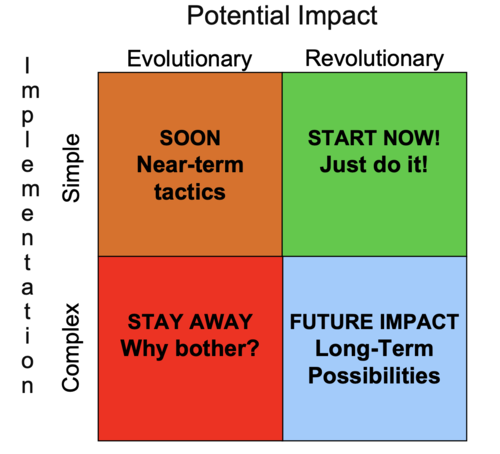BUSINESS BEST PRACTICES
Planning for 2021 Growth
Four Quick SWOT Exercises to Move a Business From Great Ideas to Real Results

many small businesses are tempted to forgo it due to time constraints
and market uncertainties. Fortunately, there is a series of concise
strategic exercises perfectly suited to the task. Courtesy Shutterstock.com
Annual business planning is a proven growth driver. Unfortunately, many small-business people may be tempted to skip that task for 2021, since traditional strategic planning often ties up time and resources. Plus, with COVID-19, who can predict the marketplace?
But branding strategist Mike Brown of The Brainzooming Group has an answer to this dilemma. In a recent SEMA360 education seminar entitled “Turning Great Ideas Into Strategies to Produce Real Results,” he presented a streamlined strengths, weaknesses, opportunities and threats (SWOT) process that can improve a team’s success through a series of bite-sized, 30-min. exercises. What’s more, Brown’s method is perfectly adapted to an uncertain business climate.
SWOT analysis is a familiar business-planning tool—so familiar that it can seem stale. But Brown believes that The Brainzooming Group’s reimagined exercises can help generate new ideas, set realistic and attainable goals, and ultimately produce business plans that make a true difference.
“We’re in a period of disruption right now, and that’s going to continue,” Brown said. “The trick is how you think about strategy and plans in a time of prolonged disruption. It can be easy to think, ‘Well, I’m just going to wing it. I’ve sort of gotten there so far and we’ve survived, so I’ll sort of see what happens.’ That’s not a great idea.”
A better idea is taking regular half-hour sit-downs to focus on different SWOT areas. The following are some of Brown’s favorite exercises that business owners can do individually or in working groups with staff.
30-Min. Strengths Exercise
A lot of business people are trying to figure out how to conduct business in the new normal, but Brown believes that it’s more useful to ask what the “new important” is right now for their brand.
“Is that going after new customers? Is it trying to win back the customers you had? Is it finding new ways to serve them, new ways to operate?” he asked. Take 30 min. to list and rank what’s currently most important. Then look at those priorities from new perspectives. How might another person see those priorities from a distance or from an opposing viewpoint or in the details or from a different angle?
“Using those four different perspectives, you’ll start to see things in a different way, and that can really help you think about the strengths of your business as you look toward 2021,” Brown said.
30-Min. Weakness Exercise
“When it comes to weaknesses, it’s not always the big, scary things that can crater a business but rather those things that are really familiar,” Brown said. He added that the key is to think about where you are right now in the current climate and, as you look ahead, anticipate other challenges that may be out there.
But how can you discover your operation’s hidden weaknesses? Brown recommends taking 20 min. to compile five lists:
- Procedures or structures that have carried your operations through so far with few or no glitches.
- Things your business is doing more often now than before.
- Aspects of your operations that you can currently afford to ignore.
- Processes you have hurriedly pieced together.
- Things you’re depending on heavily right now.
“Take about 20 min. to look at those things and then another 10 min. to ask, ‘What happens if they fail now? Where are we going to see the challenges?’” Brown suggested. “If you can do that exercise, it’s a great way to get a handle not only on your traditional weaknesses in business—because, again, we’re not in a traditional time right now—but those things that are working but which could fail in the months ahead during 2021.”
Once those weaknesses are identified, you can begin to put plans in place to try to address them.

ideas that none ever get implemented. Brainzooming suggests
creating an idea list, choosing 20% of those ideas, and then plotting
that 20% on a chart like the one above. By arranging ideas based
upon potential impact and ease of implementation, you can more
easily choose the best ones to greenlight.
30-Min. Opportunities Exercise
“The ‘O’ in SWOT is ‘opportunities,’ and that means thinking about how you grow and develop your brand during this crazy time that’s still going on,” Brown said. To assist with identifying new opportunities, The Brainzooming Group has come up with several 30-min. modules, starting with a customer-focused exercise.
“One of the most important things is to think about where your customers’ heads are,” he said. “Do you really know where they’re at? Have you been talking to them, surveying them and reaching out to them? During times when you’ve been shut down, have you stayed in touch?
“It’s interesting that when we talk to people in different regions of the country, their mindsets are in different places. Some people are like, ‘Hey, this thing has passed, it’s over, we’re going to keep rolling.’ Other people are really still [sheltering] in place, suffering with preexisting conditions, feeling at high risk and saying, ‘I don’t know when I’m going to leave the house again.’ And there’s everything in between.
“Don’t just make assumptions as you think about opportunities and what your customers are thinking right now—find ways to reach out to them.”
While Brown acknowledged that actually reaching out obviously takes more than 30 min., he noted that a business planner can easily sit down and ask what they should know about their customers in 30 min. That will naturally lead to new opportunities for addressing customers’ changing needs.
30-Min. Threat Exercise
Typically, Brown said, businesses look at institutional issues or outside factors as threats, but planners often miss a more general threat right under their noses: how they prioritize ideas.
“A lot of businesspeople and entrepreneurs tell me they have ideas all the time but just don’t get to all of them—there’s just way too many,” he explained.
To overcome that, Brown advised drawing up a grid of four squares (see illustration above) representing evolutionary ideas that are simple to do, revolutionary ideas that are simple to implement, evolutionary ideas that are complex to achieve, and revolutionary ideas that are complex to achieve. Next, gather a list of ideas and place each one individually into an appropriate square on the chart.
The priority ideas will quickly emerge in the “revolutionary and simple” square. Those will be the ideas a business will want to jump on. The ideas revealed in the “evolutionary and complex” square can take on the lowest priority.
 Resources
Resources
To see the full video of Mike Brown’s SEMA360 education session, along with other best-practices videos, visit www.sema.org/virtual-education.
In addition to the simple SWOT exercises presented here, The Brainzooming Group has developed a full suite of related strategy sessions to aid planning amid business disruptions. To access them, visit info.brainzooming.com/30minutestrategyexercises.






